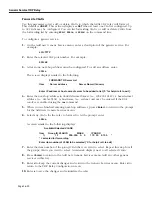
Introduction
Page 27-2
IPX Routing Overview
In IPX routing, the switch builds routing tables to keep track of optimal destinations for traf-
fic it receives that is destined for remote IPX networks. The switch sends and receives rout-
ing messages, or advertisements, to/from other routers in the network. When the switch
receives an IPX packet, it looks up the destination network number in its routing table. If the
network is directly connected to the switch, the switch also checks the destination node
address. The network number consists of eight hex digits, and the node address is typically
the
MAC
address of the end station or server.
Creating routing tables is performed by switch software unless a Hardware Routing Engine
(HRE) or HRE-X is installed. The HRE or HRE-X significantly improves routing performance.
See Chapter 1, “Omni Switch/Router Chassis and Power Supplies,” for information about the
HRE-X respectively.
IPX is associated with additional protocols built into the switch software. These are described
in the next section.
IPX Protocols
The switch supports the following IPX protocols:
•
SPX
(Sequenced Packet Exchange) is a Transport-layer protocol that provides a reliable
end-to-end communications link by managing packet sequencing and delivery. SPX does
not play a direct role in IPX routing; it simply guarantees the delivery of routed packets.
•
IPX RIP
(Routing Information Protocol) is a layer 3 protocol used by NetWare routers to
exchange IPX routing information. IPX RIP functions similarly to IP RIP. IPX RIP uses two
metrics to calculate the best route: hop count and ticks. An IPX router periodically trans-
mits packets containing the information currently in its own routing table to neighboring
IPX RIP routers in order to advertise the best route to an IPX destination.
•
SAP
(Service Advertising Protocol) is a layer 3 protocol used by NetWare routers to
exchange IPX routing information. SAP is similar in concept to IPX RIP. Just as RIP enables
NetWare routers to exchange information about routes, SAP enables NetWare devices to
exchange information about available network services. NetWare workstations use SAP to
obtain the network addresses of NetWare servers. IPX routers use SAP to gather service
information and then share it with other IPX routers.
Summary of Contents for Omni Switch/Router
Page 1: ...Part No 060166 10 Rev C March 2005 Omni Switch Router User Manual Release 4 5 www alcatel com ...
Page 4: ...page iv ...
Page 110: ...WAN Modules Page 3 40 ...
Page 156: ...UI Table Filtering Using Search and Filter Commands Page 4 46 ...
Page 164: ...Using ZMODEM Page 5 8 ...
Page 186: ...Displaying and Setting the Swap State Page 6 22 ...
Page 202: ...Creating a New File System Page 7 16 ...
Page 270: ...Displaying Secure Access Entries in the MPM Log Page 10 14 ...
Page 430: ...OmniChannel Page 15 16 ...
Page 496: ...Configuring Source Route to Transparent Bridging Page 17 48 ...
Page 542: ...Dissimilar LAN Switching Capabilities Page 18 46 ...
Page 646: ...Application Example DHCP Policies Page 20 30 ...
Page 660: ...GMAP Page 21 14 ...
Page 710: ...Viewing the Virtual Interface of Multicast VLANs Page 23 16 ...
Page 722: ...Application Example 5 Page 24 12 ...
Page 788: ...Viewing UDP Relay Statistics Page 26 24 ...
Page 872: ...The WAN Port Software Menu Page 28 46 ...
Page 960: ...Deleting a PPP Entity Page 30 22 ...
Page 978: ...Displaying Link Status Page 31 18 ...
Page 988: ...Displaying ISDN Configuration Entry Status Page 32 10 ...
Page 1024: ...Backup Services Commands Page 34 14 ...
Page 1062: ...Diagnostic Test Cable Schematics Page 36 24 ...
Page 1072: ...Configuring a Switch with an MPX Page A 10 ...
Page 1086: ...Page B 14 ...
Page 1100: ...Page I 14 Index ...
















































